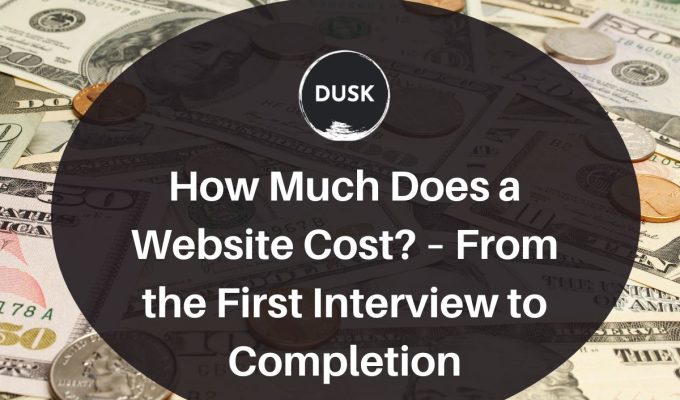In today’s digital age, having a website has become necessary for businesses and individuals. A website can serve as a digital storefront, communication platform, or revenue generation.
However, one question always arises, “How much does a website cost?”
The answer to this question depends on various factors. For instance, if you choose to use a website builder, it could cost you as little as $6 per month, whereas using WordPress increases that monthly price to anywhere between $11 and $50. Hiring a website designer is the most expensive option, with an upfront price of over $5,000.
In this article, we will explore the website development process from the first interview to completion and discuss the factors that impact the cost of a website.
Table of Contents
Website Development Process

Step 1: Initial Consultation
The website development process typically begins with an initial consultation between the client and the web development team. During this consultation, the client discusses their vision for the website, and the web development team better understands the client’s needs and expectations.
The web development team may ask questions about the type of website the client wants, the target audience, the functionality required, and the timeline for completion.
Step 2: Planning and Design
Once the client’s needs and expectations have been established, the web development team will move on to the planning and design phase.
This involves creating a plan for the website’s structure and layout and designing a mock-up or prototype of the website. The design phase typically includes creating a color scheme, selecting fonts, and designing the website’s user interface.
The cost of this phase can vary depending on the complexity of the website and the amount of time it takes to create a design that meets the client’s needs.
Step 3: Development
After the planning and design phase, the web development team will begin the development phase. This involves coding the website and adding functionality such as forms, shopping carts, and databases.
The cost of this phase can vary depending on the complexity of the website and the amount of time it takes to develop its functionality. During this phase, the website may also be optimized for search engines, which can affect the cost of the website.
Step 4: Testing and Launching
Once the website has been developed, it will undergo testing to ensure that it is functioning correctly and that there are no bugs or errors.
The cost of this phase can vary depending on the complexity of the website and the amount of time it takes to test and debug the website. Once testing is complete, the website will be launched and made available to the public.
The cost of launching the website can vary depending on the hosting provider and the domain name.
Factors that Impact the Cost of a Website
Following your understanding of the primary web development process, let’s discuss the factors that affect the cost of each step. For starters, there are three basic methods for building a website, and the one you select can greatly affect the price of your website.
- Use website builder
- Build with WordPress
- Hire a web designer
Here are some of the most important factors:
Complexity
The complexity of the website is one of the most significant factors that can impact the cost. A simple website with just a few pages will cost significantly less than a complex website with multiple pages, forms, and databases. The more complex the website is, the more time and effort are required to develop it, which will drive the cost.
Design
The design of the website can also impact the cost. A custom design that requires a lot of time and effort will cost more than a pre-designed template that can be easily modified. The website’s design can include the layout, color scheme, typography, and overall aesthetic, which can affect the cost.
Functionality
The functionality required for the website can also impact the cost. Adding features such as e-commerce functionality or a customer portal will increase the cost of the website. More advanced functionality will require more development time, increasing the cost.
Content
The amount and type of content required for the website can also impact the cost. Creating high-quality content such as videos, images, and copy can be time-consuming and can increase the cost of the website. Additionally, the more content required, the more time it will take to develop the website, increasing the cost.
Timeline
The timeline for completing the website can also impact the cost. Rushing a website development project can result in a higher cost due to the need for additional resources and overtime. A realistic website development project timeline is crucial to avoid unnecessary costs.
Platform
The platform on which the website is built can also impact the cost. Custom-built websites created from scratch will cost more than websites built using pre-existing platforms such as WordPress or Shopify. The cost of the platform will depend on the features and functionality required for the website.
As mentioned above, using a website builder could cost you as little as $6 per month, whereas WordPress increases that monthly price to anywhere between $11 and $50. Hiring a website designer is the most expensive option, with an upfront price of over $10,000.
Maintenance
Finally, ongoing maintenance and updates to the website can also impact the cost. Websites that require regular updates and maintenance will cost more than websites that require less maintenance. It is important to consider ongoing maintenance costs when developing a website to avoid unexpected costs in the future.
Overall, several factors can impact the cost of a website. Considering these factors when developing a website is vital to ensure that the final product meets your needs and fits within your budget.
Conclusion: How Much Does a Website Cost?
The cost of a website can vary depending on several factors. The development process typically begins with an initial consultation, planning and design, development, testing, and launch. Factors that impact the cost of a website include complexity, design, functionality, content, and timeline.
There are also three main ways to build a website. You can use a website builder, build with WordPress, or hire a web designer. Which method you choose will significantly impact how much your website costs. You must select the approach that works best for you.
Creating content can be free with a web builder but can cost over $5,000 if you use a web designer or developer. Although it is more expensive, the latter relieves you of the technical difficulty. Although using a website builder is inexpensive and simple, WordPress gives you more control over your content. WordPress gives you versatility, but it requires the greatest time and involvement.
Nonetheless, you should anticipate paying an upfront fee of about $200 and an ongoing fee of about $50 per month to construct and maintain a website.






